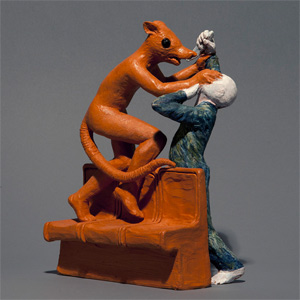1959 – 2021
Known professionally as Henriette Valium, Patrick Henley was a comic book artist and “painter of unsurpassed strangeness” based in Montreal, Québec. He started drawing as a child and gained recognition in the underground comic scene in Europe and North America at the start of his career in the 1980s. His outrageous and hallucinogenic style kept him from the mainstream comic book industry.
Henley won the Pigskin Peters Award at the 2017 Doug Wright Awards for his graphic novel Palace of Champions (Conundrum, 2016). His art has been published in numerous anthologies as well as his own books: 1000 It’s an Album Valium! (self-published, 1987); Primitive Cretin (self-published, 1994); Elle Est De Retour! (1989); Maladies (1991); The Clinical Visit (1995); La Prison Anale des Freres Rouges (1996); Curées Malades (2000); and Mother’s Heart (2000).

























































